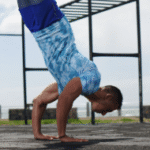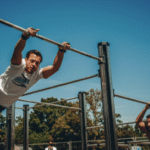How to Master the Pull-Up: A Houston Trainer’s Guide
From the perspective of a professional Houston calisthenics trainer, mastering the pull-up is a journey of consistency, proper progression, and building a strong foundation. It’s a foundational bodyweight exercise that, when done correctly, is a true measure of upper-body strength and a gateway to more advanced calisthenics skills.
Here is a detailed, step-by-step guide from a Houston trainer’s perspective on how to master the pull-up.
Step 1: Build the Foundation (It’s Not Just About Your Arms)
The most common mistake beginners make is thinking the pull-up is a bicep exercise. A good trainer in Houston would tell you that it’s a full-body movement that starts with a strong core and a solid grip.
Dead Hangs: This is the first and most important exercise. Simply hang from a pull-up bar for as long as you can. This builds grip strength, shoulder health, and prepares your body for the stress of a pull-up. Aim to increase your hang time every session.
Core Strength: A tight, engaged core prevents your body from swaying and helps transfer force from your back to your arms. Practice planks and hollow body holds to build the necessary core stability.
Scapular Pulls: From a dead hang, pull your shoulder blades down and back, lifting your body slightly without bending your arms. This teaches you how to engage your back muscles, which are the primary movers in a pull-up.
Step 2: Use the Right Progressions (Go from Easy to Hard)
A professional trainer in Houston would never have a beginner jump straight into a pull-up. The key is to use progressions that build the necessary strength incrementally.
Australian Pull-ups (Inverted Rows): Use a low bar, like a dip bar, and lie underneath it with your body straight. Pull your chest up to the bar. This exercise is great because you can adjust the difficulty by changing your body angle.
Band-Assisted Pull-ups: Use a resistance band looped around the bar and under your feet. The band will assist you on the way up, allowing you to focus on the proper form. As you get stronger, you can use a lighter band.
Negative Pull-ups: This is an excellent way to build the strength needed for the lowering portion of the pull-up. Jump to the top of the bar and then slowly, with control, lower yourself down. Aim for a 5-second descent.
Step 3: The Role of Accessory Exercises
A good Houston trainer’s guide would include accessory exercises to strengthen the supporting muscles.
Lat Pull-downs (at a gym): If you’re training at a gym, the lat pull-down machine is a great way to build the strength in your back (lats).
Dumbbell Rows: This exercise is great for building the strength and density in your back muscles.
Bicep Curls: While not the main muscle in a pull-up, strong biceps will certainly help.
Step 4: Practice and Consistency (The Houston Trainer’s Mantra)
The key to mastering the pull-up is not a single workout; it’s consistent effort over time.
Frequency: Practice pull-up progressions 2-3 times a week, with a rest day in between.
Where to Train in Houston: Houston has excellent resources for this. Memorial Park and Hermann Park have dedicated pull-up bars. If you’re looking for a structured environment, Houston has specialized calisthenics gyms with professional coaches who can guide you through every step of this journey.
In conclusion, mastering the pull-up is a challenging but rewarding process. By following this progressive, foundation-focused guide, you’ll be well on your way to achieving a powerful and functional pull-up.

How to Master the Pull-Up: A Houston Trainer’s Guide
Route
Calisthenics Gym Houston Functional Bodyweight Training
Secondary phone: (346) 483-3195
Email: info@calisthenicsclubhouston.com
URL: https://calisthenicsclubhouston.com/
Monday 6:00 AM - 7:00 PM Tuesday 6:00 AM - 7:00 PM Wednesday 6:00 AM - 7:00 PM Thursday 6:00 AM - 7:00 PM Friday 12:00 PM - 6:30 PM Saturday 9:45 AM - 12:00 PM Sunday 3:00 PM - 5:00 PM





